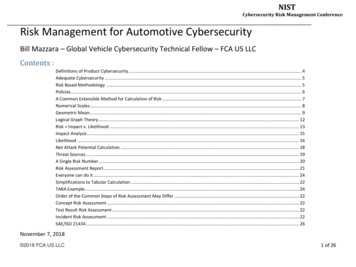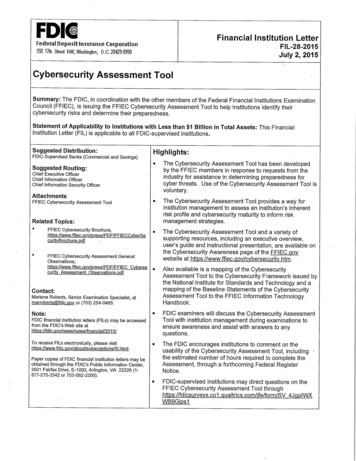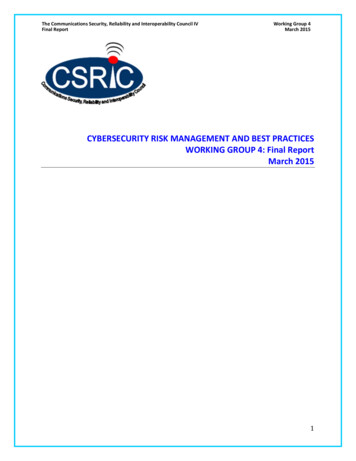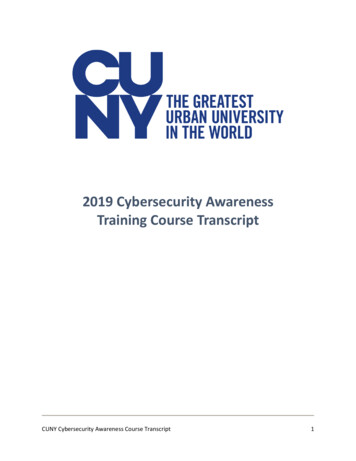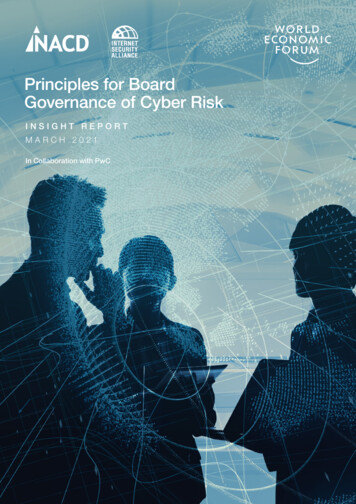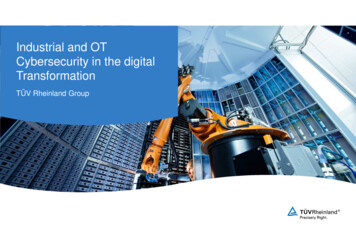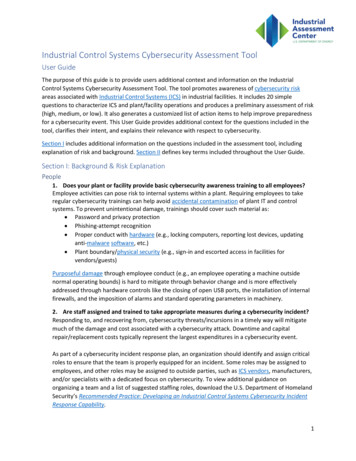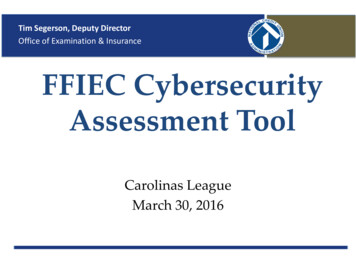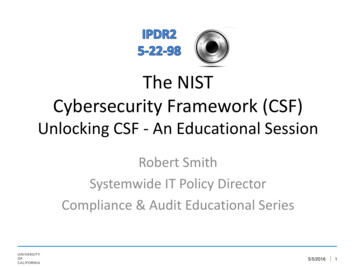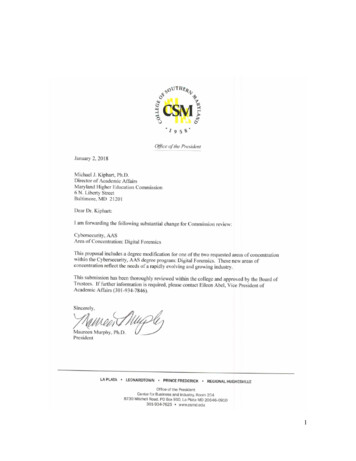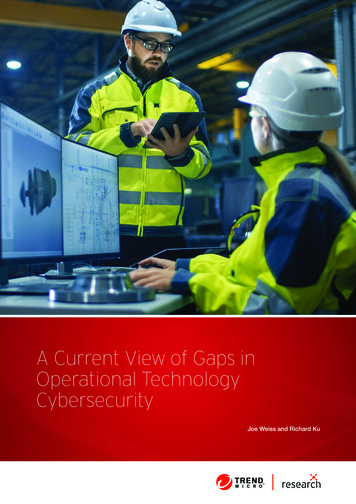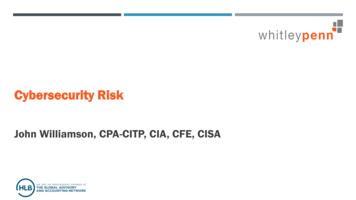
Transcription
Cybersecurity RiskJohn Williamson, CPA-CITP, CIA, CFE, CISA
KEY DEFINITIONSIncidents vs. Breaches An incident is a security event that compromises the integrity, confidentiality, or availability of an information asset. A breach is an incident that results in the confirmed disclosure – not just potential exposure – of data to anunauthorized party.Personal Data Personal data are data that allow the identification of a person directly or indirectly. Name and surnameHome addressEmail addressIdentification card numberLocation data Cookie ID Advertising identifier of yourphone Data held by a hospital or doctor2
KEY DEFINITIONSProtected Health Information (PHI)PHI is any information that can be used to identify an individual, and that was created, used, ordisclosed in the course of providing a health care service, such as a diagnosis or treatment.Governed by the Health Insurance Portability and Accountability Act of 1996. Patient NamesPatient AddressDates of ServiceProcedure Codes Diagnosis CodesLab Test ResultsPrescriptionsPhone Records3
HISTORY OF HIPAA Required HHS to adopt national standards for electronic health care transactions and code sets, uniquehealth identifiers, and security. Incorporated into HIPAA provisions that mandated the adoption of Federalprivacy protections for individually identifiable health information. HHS published a final Privacy Rule in December 2000, set national standards for the protection ofindividually identifiable health information by three types of covered entities: health plans, health careclearinghouses, and health care providers who conduct the standard health care transactions electronically. HS published a final Security Rule in February 2003. This Rule sets national standards for protecting theconfidentiality, integrity, and availability of electronic protected health information. HHS enacted a final Omnibus rule in 2013 that implements a number of provisions of the HITECH Act tostrengthen the privacy and security protections for health information established under HIPAA, finalizingthe Breach Notification Rule and extending compliance requirements to Business Associates.4
BREACH NOTIFICATION RULES Notify data subjects within 60 days following the discovery of a breach. Covered entities must post the notice to its website or advertise in a media publication. Proof of burden for breach notification rests with the covered entity or businessassociate, as applicable. All breaches affecting more than 500 individuals are posted to the HHS website.5
TRENDS IN DATA BREACHESSource: Verizon Data Breach Investigation Report6
CYBERSECURITY POP QUIZWhat percentage of breaches involve a form of phishing?A.43%B.22%C.91%D.78%Source: Verizon Data Breach Investigation Report7
CYBERCRIME FINANCIAL IMPACT(COST PER RECORD, BY INDUSTRY)Source: Ponemon Institute Cost of a Breach Report8
HHS FINES FOR DATA BREACHES9
CYBERCRIME FINANCIAL IMPACTSource: Federal Bureau of Investigation10
CYBERCRIME FINANCIAL IMPACTCosts of1.5 Trillion USD (2021)Cybercrime1% of global GDP 8.9M average cost of USbreachSource: Federal Bureau of Investigation11
TRENDS IN DATA BREACHESSource: Verizon Data Breach Investigation Report12
CYBERSECURITY POP QUIZWhich of the following is an example of two-factor authentication? Your Username &Password and A.Answering two personal questions to confirm your identityB.Typing two unique words based on CAPTCHA imagesC.Entering a password after viewing a unique security imageD.Entering a unique one-time code that has been sent via SMS13
CASE STUDY 1: SOLARWINDS BREACHIn December 2020, cybersecurity firmFireEye announced that it was subject to astate-sponsored attack.During a forensic investigation, FireEyelearned that the compromise was a part of amuch larger breach of SolarWind’s Orionsoftware.14
CASE STUDY 1: SOLARWINDS BREACHThe Washington Post reported that FireEyeattributed the breach to APT29, a statesponsored Russian hacking group.Evidence suggests that APT29 isassociated with the Russian ForeignIntelligence Service (SVR).Code name: “Cozy Bear"15
CASE STUDY 1: SOLARWINDS BREACH SolarWinds is one of the world’s largest developers of network monitoring tools. Between March 2020 and June 2020, SolarWinds released several versions of its flagshipproduct, Orion. The attackers modified a plug-in that is distributed as part of Orion platform updates. Thetrojanized component contains a backdoor that communicates with third-party servers controlledby the attackers. The malware is known as “Sunburst”16
CASE STUDY 1: SOLARWINDS BREACH After an initial dormant period of up to two weeks, the malware retrieves and executes commandsthat include the ability to transfer files, execute files, profile the system, reboot the machine, anddisable system services. The malware masquerades its network traffic as an Orion protocol and stores reconnaissanceresults that blend in with legitimate SolarWinds activity. The attackers kept their footprint very low, preferring to steal and use credentials to perform lateralmovement through the network and establish legitimate remote access. The backdoor was used todeliver a lightweight malware dropper, which loads directly in memory and does not leave traceson the disk.17
TIMELINE OF THE BREACHAPT accessesSolarWindsSUNBURST compiledand deployedHotfix 5 DLLavailable tocustomersAPT injects test codeand begins trial run9/4/2019SolarWindsreleases severalversions of Orion9/12/20192/20/20203/26/2020SolarWindsreleases patchSolarWinds isnotified ofSUNBURSTApril/May 202012/12/2020US-CERT alertissued12/15/2020 12/17/2020
CASE STUDY 1: SOLARWINDS BREACHSolarWinds Customers: 425 of the US Fortune 500 The Top 10 US Telecom Companies All Branches of the US Military The Pentagon The State DepartmentOpen-source detection tools have been released to the public and new versions of Orion have removed thevulnerability.19
CYBERSECURITY POP QUIZWhat is the first step that you should take if you are the victim of a ransomware attack.A.Pay the ransom.B.Report the attack to your local FBI office.C.Disconnect the device from the network.D.Restore your production systems to your most recent backup.E.Attack your device with a baseball bat.20
CASE STUDY 2: COLONIAL PIPELINE HACKOn May 7, 2021, Colonial PipelineCompany fell victim to a ransomwareattack. In an attempt to contain themalware, the Company shut down itsoperational systems.It was the largest cyberattack on an oilinfrastructure target in US history.21
CASE STUDY 2: COLONIAL PIPELINE HACKMandiant, a division of FireEye, attributed thebreach to DarkSide, an Eastern Europeanorganized crime group. Publicizes itself as “apolitical” Ransomware-as-a-Service Robinhood of hackers?22
CASE STUDY 2: COLONIAL PIPELINE HACK Colonial Pipeline is the largest pipeline for refined oil products in the US. Hackers gained entry into the Colonial Pipeline environment on April 29 through acompromised VPN account. The account’s password has since been discovered inside a batch of leaked passwordson the dark web. Most likely, a Colonial employee may have used the same password onanother account that was previously hacked. The VPN account did not use multi-factor authentication (“MFA”).23
CASE STUDY 2: COLONIAL PIPELINE HACK On May 7, an employee in Colonial’s control room saw a ransom note demanding cryptocurrencyappear on a computer just before 5 a.m. The CEO was notified of the ransom, by 6:10 am, the pipeline was shut down. The ransomware was deployed on the Company’s billing software, the operational technologynetwork remained unaffected. Colonial paid DarkSide 4.4M in Bitcoin for the decryption key, but recovery remained slow. Operations resumed on May 12. On June 7, the DOJ announced that it assisted in recovering 2.3M in Bitcoin payments.24
CASE STUDY 3: BUSINESS EMAIL COMPROMISE Texas-based midsize healthcare company Business email compromise for 275,000 What happened: Accounting Manager gets an email from the COO asking to transfer funds to a new vendor. The email included correspondence between the COO and the new vendor discussing the initial paymentand a change in payment instructions. Emails from the vendor claimed that the original bank account had been closed, which included a forgedaccount closing letter. The Accounting Manager and Controller released the funds. Three weeks later, the vendor inquired about the payment claiming it was never received.25
CASE STUDY 3: WHAT WENT WRONG Multi-factor authentication (MFA) was rolled out one year prior, but it was made optional toemployees. The COO never enabled MFA and the email account was hacked by using a 365 remoteaccess terminal. The bad actor setup a rule to automatically delete any emails sent from the attacker. After one to two weeks of monitoring the COO’s emails, the attacker created a scheme usingintelligence from email monitoring. There was a lack of security awareness training and call back procedures for paymentinstruction changes.26
ELECTRONIC VENDOR FRAUD ATTACKMETHODSDomain ImpersonationDomain ImpersonationDomainimpersonationoccursan attacker appears to use aDomain whenimpersonationoccurs whenan attackercompany'sdomain to impersonateappears to use a company'sa company or one of its employees.domain to impersonate aThiscancompanyor oneofbeits done by sending emailsemployees.can bedomaindonewithThisfalsenames whichby sendingemailslegitimate,with false or by setting upappeardomain names which appearwebsiteswithslightly alteredlegitimate,or by settingupwebsitescharacterswith slightlythatalteredread as correct.characters that read ascorrect.
ELECTRONIC VENDOR FRAUD ATTACKMETHODSSpoofingThe attackermodifies thesender’s emailSpoofingaddresstoThe attackermodifies thesender’semail address to matchidenticallyidentically match a trustedsource. a trusted source.
EMAIL ATTACKS ARE ON THE RISE29
30
CYBERSECURITY POP QUIZWhich of the following password policies is considered to be more secure:A.8 character password with special characters changed every 3 months.B. 16 character password with special characters changed every year.31
CYBERSECURITY POP QUIZ32
CYBERSECURITY BEST PRACTICES: “TOP 10”1.Cybersecurity Governance2.Data Classification and Mapping3.Third-Party Risk Management4.Security Awareness Training5.Incident Response Planning6.Asset Inventory7.Vulnerability Management8.Restriction of privileged access9.Perimeter defenses and anti-malware10.Recoverability33
VENDOR MAINTENANCE BEST PRACTICES Email sandboxing for all inbound emails & MFA. Corroborate all request for changes to vendor address and/or banking information by phone, NOT email. Usepreviously known numbers you know are correct and not the numbers provided in an email or text request. Revise forms to require vendors to provide BOTH old and new bank routing and account numbers or billingaddresses when requesting a bank change or a payment mailing change. Remove vendor change forms from website. Have vendors contact staff directly for forms. Consider two-party sign-off on payment instructions. Require documentation (specific forms/voided checks/bank letters). Conduct end user training. Incident response planning.
SOC SUITE OF SERVICES: MANAGING 3RD PARTYRISKSOC 1 – SOC for Service Organizations: ICFR Report on Controls at a Service Organization Relevant to User Entities’ Internal Control over Financial Reporting (ICFR)SOC 2 – SOC for Service Organizations: Trust Services Criteria Report on Controls at a Service Organization Relevant to Security, Availability, Processing Integrity, Confidentiality or Privacy SOC for Service Organizations: SOC 2 (CSA STAR, ISO 27001, HIPAA Security Rule, GDPR, NIST CSF, COBIT, HITRUST)SOC 3 – SOC for Service Organizations: Trust Services Criteria for General Use Report These reports are designed to meet the needs of users who need assurance about the controls at a service organization.New: SOC for Cybersecurity A reporting framework for communicating information about the effectiveness of cybersecurity risk management program to abroad range of stakeholdersNew: SOC for Vendor Supply Chains An internal controls report on a vendor’s manufacturing processes for customers of manufacturers and distributors to betterunderstand the cybersecurity risk in their supply chains.
INFORMATION SECURITY FRAMEWORK THAT INCLUDES 44 AUTHORITATIVESOURCES (HIPAA, NIST, ISO 27001, GDPR, ETC.) AND OFFERS A CERTIFICATIONPROGRAM TO DEMONSTRATE COMPLIANCE TO 3RD PARTIES. OFFERS ACOMPREHENSIVE SECURITY, PRIVACY, AND COMPLIANCE SOLUTION.INCLUDES CONSIDERATION ESTABLISHED MATURITY LEVELS, INCLUDINGPOLICIES, PROCEDURES, IMPLEMENTATION, MEASURED, AND MONITORED. ITALSO OFFERS AN OPTION OF SOC 2 AND A CERTIFICATION.36
37
HITRUST CERTIFICATION Premier certification for the healthcare sector, with a specific emphasis on safeguarding PHI. Multiple certification options, including a readiness assessments. Flexibility for full certification or a SOC 2 report. Demonstrates capabilities to healthcare clients, business partners, payers, and service providers. Can be marketed to stakeholders and the public to demonstrate commitment to secure information securityand privacy practices.38
Contact Information:John com39
CASE STUDY 1: SOLARWINDS BREACH SolarWinds is one of the world's largest developers of network monitoring tools. Between March 2020 and June 2020, SolarWinds released several versions of its flagship product, Orion. The attackers modified a plug-in that is distributed as part of Orion platform updates. The trojanized component contains a backdoor that communicates with third-party servers .
